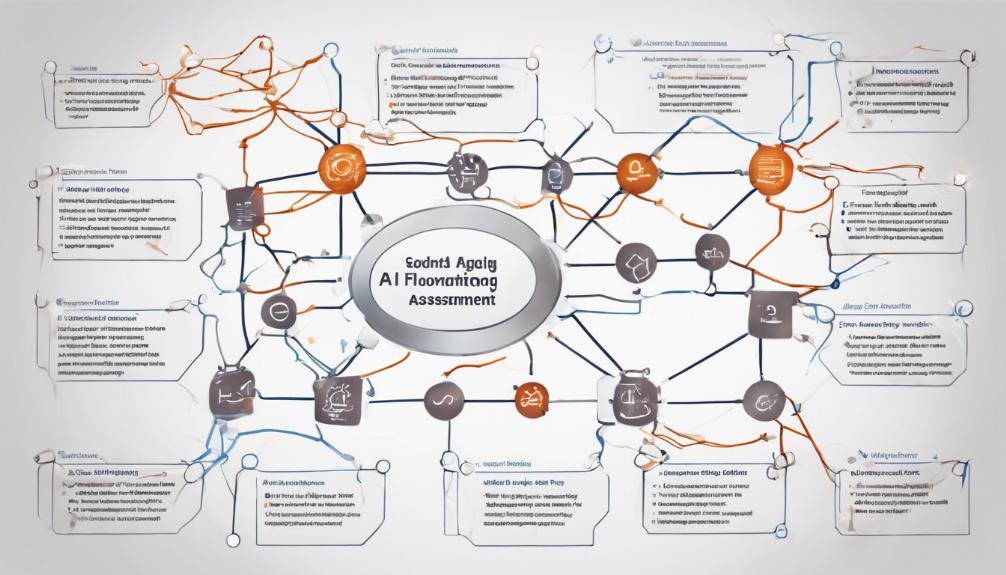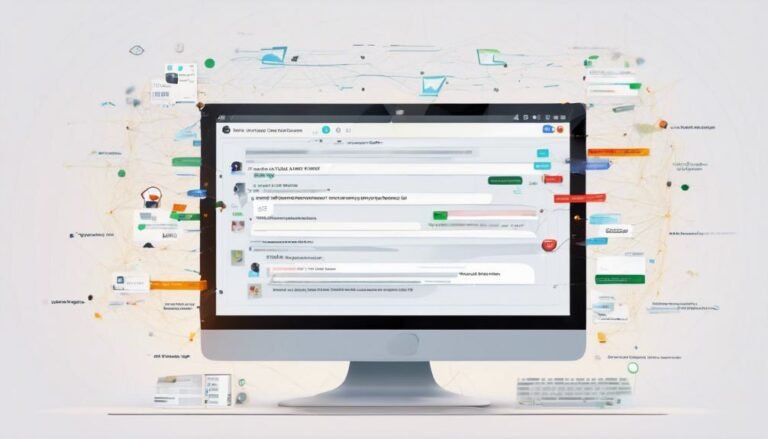AI in Product Risk Assessment
In the domain of product risk assessment, the integration of AI stands as a pivotal advancement reshaping traditional methodologies. By harnessing the power of AI algorithms, organizations can gain invaluable insights into potential risks, thereby revolutionizing their risk management strategies. However, as AI continues to evolve in this domain, critical questions emerge regarding its ethical implications and the robustness of its decision-making processes. This nuanced interplay between technology and risk assessment prompts a closer examination of how AI is redefining the landscape of product safety and incident prevention.
Key Takeaways
- AI improves risk prediction accuracy and efficiency.
- Ethical considerations crucial for unbiased assessments.
- Compliance with industry regulations and ethical standards.
- Automation streamlines risk assessment processes.
- Data-driven decisions empower proactive risk mitigation strategies.
The Role of AI in Risk Assessment
How does artificial intelligence revolutionize the process of risk assessment in product development?
AI implementation in risk assessment brings numerous benefits but also raises important considerations. One key aspect is the potential for AI bias, where algorithms may unintentionally discriminate against certain groups, impacting the accuracy and fairness of risk assessments. Ethical considerations must be at the forefront when developing AI systems to guarantee they do not perpetuate biases or inequalities.
Moreover, regulatory compliance is a vital factor in utilizing AI for risk assessment.
Companies must adhere to industry-specific regulations and standards when implementing AI technologies to assess product risks effectively. Failure to comply with these regulations could lead to legal repercussions and damage to the company's reputation.
Benefits of AI Integration
The integration of AI in product risk assessment brings about significant benefits, primarily in the areas of enhanced risk prediction and improved decision-making efficiency. Through advanced algorithms and data analysis, AI can accurately predict potential risks associated with products, allowing for proactive risk mitigation strategies.
Additionally, the automation of risk assessment processes can streamline decision-making, enabling faster responses to emerging risks and enhancing overall risk management practices.
Enhanced Risk Prediction
By integrating AI technology into product risk assessment processes, organizations can achieve enhanced risk prediction capabilities, enabling more accurate identification and mitigation of potential risks.
AI applications, such as predictive modeling, enhance risk assessment by analyzing vast amounts of data to identify patterns and trends that may not be evident through traditional risk management techniques. This allows businesses to proactively address risks before they escalate, leading to more effective risk mitigation strategies.
AI's predictive capabilities also enable organizations to anticipate potential risks based on historical data and real-time information, providing a more thorough understanding of the risk landscape.
By leveraging AI algorithms, companies can prioritize risks based on their likelihood and potential impact, allowing for a more targeted allocation of resources towards high-priority areas. This not only streamlines risk management processes but also enhances overall risk preparedness and resilience.
Essentially, the integration of AI into risk assessment processes empowers organizations to make informed decisions and implement targeted risk mitigation strategies that align with their business objectives.
Improved Decision-Making Efficiency
Enhancing decision-making efficiency through the integration of AI technology in product risk assessment processes yields significant benefits for organizations. By leveraging AI efficiency, businesses can optimize decision-making processes by automating risk assessment tasks and gaining data-driven insights.
AI algorithms can analyze vast amounts of data quickly and accurately, providing organizations with valuable information to make informed decisions.
Through AI integration, decision-makers can streamline the evaluation of potential risks associated with products, enabling them to prioritize and address critical issues promptly. This not only saves time but also enhances the overall effectiveness of risk assessment procedures.
Additionally, AI can assist in identifying patterns and trends within the data that may not be apparent through traditional methods, further improving decision-making processes.
Challenges in Implementation
One significant obstacle encountered in implementing AI for product risk assessment is the complexity of integrating AI algorithms with existing risk assessment frameworks. This challenge arises due to the need for AI systems to adapt to the specific requirements and nuances of different industries and products. Technology limitations also play an important role in hindering the seamless integration of AI into risk assessment processes.
Another key implementation challenge is the availability and quality of data required to train AI models effectively. Insufficient or biased data can lead to inaccurate risk assessments and unreliable predictions. Additionally, ensuring the transparency and interpretability of AI algorithms poses a significant hurdle in gaining trust and acceptance from stakeholders.
Additionally, the scalability of AI solutions for product risk assessment is a pressing issue. Adapting AI models to handle large volumes of data and diverse risk factors while maintaining efficiency and accuracy remains a complex task.
Overcoming these challenges demands a holistic approach that addresses both technical limitations and operational constraints in integrating AI into product risk assessment frameworks.
Predictive Analytics in Risk Assessment
Utilizing predictive analytics in risk assessment enables organizations to proactively identify potential risks and trends based on historical data and statistical modeling. Through data interpretation, organizations can extract valuable insights to enhance risk mitigation strategies. Predictive modeling plays an essential role in risk evaluation by forecasting potential outcomes and evaluating the likelihood of risks materializing.
By leveraging predictive analytics, organizations can anticipate and prepare for potential risks before they escalate, thereby minimizing the impact on operations and resources. This data-driven approach allows for a more thorough understanding of complex risk factors and enables informed decision-making to mitigate those risks effectively.
Furthermore, predictive analytics provides a structured framework for organizations to prioritize risks based on their probability and potential impact. This systematic approach enhances risk management processes by focusing efforts and resources on areas with the highest risk exposure.
Ultimately, predictive analytics empowers organizations to proactively manage risks, enhance resilience, and drive sustainable business growth.
Machine Learning Algorithms for Risk
Machine learning algorithms play a crucial role in enhancing risk assessment processes by leveraging advanced computational techniques to analyze data and predict potential risks. These algorithms enable organizations to derive AI-driven insights and implement robust risk management strategies.
- AI Driven Insights:
Machine learning algorithms can sift through vast amounts of data to uncover patterns and trends that may not be apparent to human analysts. This enables the generation of valuable AI-driven insights that can inform decision-making processes in risk assessment.
- Risk Management Strategies:
By utilizing machine learning applications, organizations can develop more effective risk management strategies. These strategies can be tailored based on the insights derived from the analysis of data, leading to proactive risk mitigation and enhanced product safety assessments.
- Product Safety Assessments:
Machine learning algorithms can assist in evaluating product safety by identifying potential risks early on in the development or manufacturing process. This proactive approach allows for timely interventions to ensure product quality and safety standards are met, ultimately reducing the likelihood of incidents or recalls.
Enhancing Accuracy With AI
Implementing AI for data analysis and utilizing advanced machine learning models can greatly enhance the accuracy of product risk assessment processes.
By harnessing the power of AI algorithms, organizations can analyze vast amounts of data swiftly and efficiently, leading to more precise risk evaluations.
This approach not only improves decision-making but also helps in identifying potential risks early on, ultimately enhancing the overall risk management strategy.
AI for Data Analysis
By employing artificial intelligence (AI) for data analysis, organizations can greatly enhance the accuracy of their product risk assessments. AI technologies such as data mining and predictive modeling can sift through vast amounts of data to identify patterns and trends that humans may overlook.
Natural language processing (NLP) enables AI systems to analyze text data, extracting valuable insights and sentiments from customer reviews, social media posts, and other textual sources. Sentiment analysis, a subset of NLP, helps organizations gauge customer satisfaction levels and potential risks associated with products or services.
Additionally, AI algorithms can analyze historical data to predict future risks more accurately than traditional methods, providing businesses with a proactive approach to risk management. By leveraging AI for data analysis, organizations can make more informed decisions and mitigate potential risks before they escalate.
Machine Learning Models
Utilizing advanced machine learning models can greatly enhance the accuracy of product risk assessments through the application of artificial intelligence technology. Model performance plays an essential role in determining the effectiveness of these assessments. By leveraging complex algorithms and vast amounts of data, machine learning models can provide more accurate predictions and insights into potential risks associated with products.
Feature selection is another key aspect when implementing machine learning models for product risk assessment. This process involves choosing the most relevant variables that contribute greatly to the prediction of risks. Through advanced feature selection techniques, such as recursive feature elimination or feature importance ranking, models can focus on the most impactful factors, leading to improved accuracy and efficiency in risk assessment tasks.
Streamlining Risk Assessment Processes
Efficiency gains can be achieved in product risk assessment through the optimization of processes and the integration of AI technologies. By streamlining risk assessment processes, organizations can realize automation benefits, enhance data utilization, optimize operations, and ultimately improve risk mitigation strategies.
Automation Benefits: Implementing AI technologies can automate repetitive tasks, such as data collection and analysis, allowing risk assessment teams to focus on more strategic decision-making processes.
Data Utilization: AI can help in extracting valuable insights from large datasets, enabling organizations to make data-driven decisions and identify potential risks more effectively.
Process Optimization: Integrating AI into risk assessment processes can streamline workflows, reducing manual errors, and enhancing the overall efficiency of risk management operations.
Through the seamless integration of AI technologies, businesses can not only streamline their risk assessment processes but also gain a competitive edge by leveraging automation benefits, improving data utilization, and optimizing their risk mitigation strategies.
Real-Time Risk Monitoring With AI
In addition, optimizing risk assessment processes through the integration of AI technologies extends to real-time risk monitoring capabilities, enhancing organizations' ability to proactively identify and respond to potential risks.
Real-time monitoring with AI involves the continuous analysis of data streams to detect anomalies, patterns, or emerging threats promptly. One of the key benefits of real-time risk monitoring through AI integration is the ability to receive instant alerts about deviations from expected norms, allowing for immediate corrective actions.
AI algorithms can process vast amounts of data in real-time, enabling organizations to monitor risks across their product lifecycle dynamically. By leveraging machine learning models, AI can learn from historical data to improve risk detection accuracy over time, making the monitoring process more refined and efficient.
Additionally, AI-powered real-time monitoring systems can adapt and evolve based on changing risk factors and trends, providing organizations with a proactive risk management approach.
Future Trends in Product Risk Assessment
Looking ahead, emerging technologies such as blockchain and IoT are poised to revolutionize product risk assessment methodologies. These advancements will enable more efficient and accurate risk evaluation processes, enhancing overall risk management strategies.
Artificial Intelligence (AI) is anticipated to play a pivotal role in the future of product risk assessment. AI algorithms can analyze vast amounts of data to identify potential risks, predict outcomes, and suggest preventive measures. This will streamline risk assessment procedures and lead to more proactive risk mitigation strategies.
The integration of blockchain technology in product risk assessment will bring unprecedented transparency and security to the process. Blockchain's decentralized nature promotes data integrity and immutability, enhancing trust in risk evaluation outcomes.
Additionally, the Internet of Things (IoT) devices will provide real-time data streams that can be leveraged for more dynamic risk assessment models, enabling quicker responses to emerging risks.
Conclusion
To sum up, the integration of AI in product risk assessment offers organizations a powerful tool to enhance decision-making processes and prioritize risks effectively. Despite challenges in implementation such as bias and interpretability, the benefits of proactive risk identification and efficient mitigation strategies outweigh the obstacles.
As AI continues to evolve and drive advancements in predictive analytics and machine learning algorithms, the future of product risk assessment holds promising opportunities for improving safety and reducing incidents proactively.







